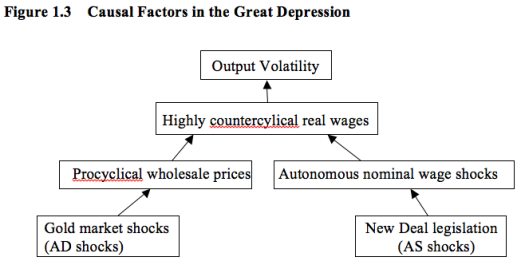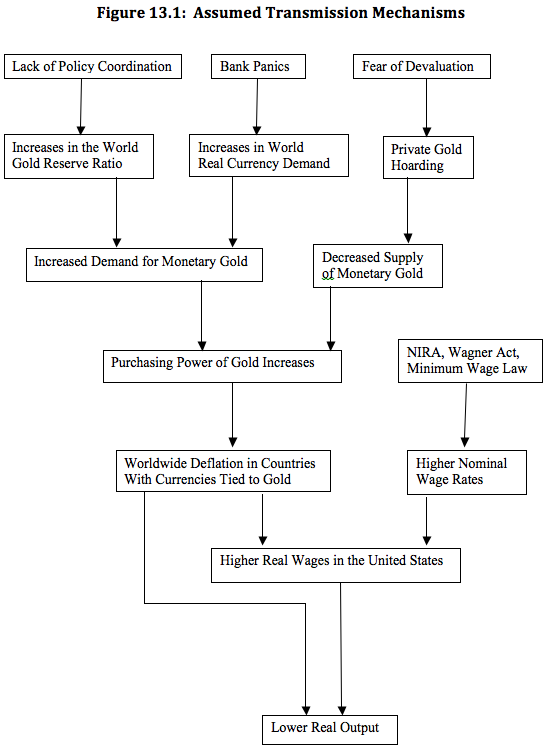Wage targeting to NGDP targeting
People often ask me for a mathematical model illustrating my views. I’m not a fan of such models, but I do understand their appeal to others. In any case, it’s not something I do, but I would encourage younger economists to take a stab at it. Here I’ll suggest one possible path.
We already have models showing that the central bank should target the stickiest prices. For instance, here’s Mankiw and Reis (2003):
This paper assumes that a central bank commits itself to maintaining an inflation target and then asks what measure of the inflation rate the central bank should use if it wants to maximize economic stability. The paper first formalizes this problem and examines its microeconomic foundations. It then shows how the weight of a sector in the stability price index depends on the sector’s characteristics, including size, cyclical sensitivity, sluggishness of price adjustment, and magnitude of sectoral shocks. When a numerical illustration of the problem is calibrated to U.S. data, one tentative conclusion is that a central bank that wants to achieve maximum stability of economic activity should use a price index that gives substantial weight to the level of nominal wages.
I made this argument in 1995, but without a rigorous model.
So how do we get from wage targeting to NGDP targeting? One problem with targeting nominal wages is that they respond to monetary policy with a lag, because they are fairly sticky. I’m not sure if this would be a big problem under level targeting, but just to play it safe it might be wise to make sure the wage target addressed the problem of policy lags.
One approach would be to target expected future wages. Earl Thompson (an under-appreciated genius, who taught David Glasner) got here first, with a sort of wage futures targeting standard, proposed back in 1982. Unfortunately Thompson passed away a few years ago, but his paper is still on the internet, and still being ignored by the profession. Maybe in about 50 years they’ll catch up to him.
Until then, how can we overcome the policy lag problem if we don’t have a wage futures market? One approach would be to target total nominal labor compensation. Suppose there is a negative demand shock, which will eventually reduce nominal wages, or at least nominal wage growth. But initially there is little or no impact, because of the stickiness of nominal wages. In that case, employment would fall before wages, and that’s indeed what we tend to see in the US business cycle. So by targeting total nominal labor compensation, the Fed could indirectly be targeting nominal hourly wages. Shifts in employment would be a sort of leading indicator of changes in nominal wages.
What could go wrong? Let’s suppose employment fell for reasons other than sticky wages, in other words the fall in total nominal labor compensation did not presage a fall in hourly wages. And let’s suppose that the Fed tried to prevent total compensation for falling. In that case, the Fed would end up pushing nominal hourly wages slightly higher, as hours worked fell. But hours worked would decline by less than if nominal wages had been held steady. The bottom line is that an attempt to maintain stable total compensation, if it were unwise from an hourly wage targeting perspective, would lead to a monetary policy that was slightly more countercyclical that desired. Surely there are worse things in the world than a slightly too countercyclical monetary policy!
I like to think of potential monetary policy rules from a “robustness” perspective. As in “What’s the worst that could happen?” With the gold standard, some pretty bad things are easy to envision, after all, the real value of gold has been highly unstable in recent decades. That’s not to say those really bad things would happen, imposition of a gold standard might substantially reduce the volatility of real gold values, but at least one can envision a really bad outcome. It’s a possibility.
I’d say the same thing regarding money supply rules. They might work well, but you can envision a big velocity shock. As far as price level targeting is concerned, you can envision a supply shock that called for a large reduction in real wages, and price level targeting preventing that from occurring in the short run. I’m not sure that this would be a particularly significant drawback of price level targeting, but it might be.
But with NGDP targeting, it’s hard for me to envision a plausible outcome that is obviously undesirable. Many people are confused on this point, mentioning the possibility of 5% inflation 0% growth, or 0% inflation and 5% growth. Yes, the first of these seems undesirable, but the bad outcome doesn’t have any clear relationship to monetary policy failure. If we had 5% inflation and 0% growth, it would not be obvious whether money was too easy or too tight, even in retrospect. (Many commenters think a monetary policy failure is “obvious” in this case, but can’t agree whether money is too easy or too tight!! QED.)
A robust policy is one where it’s hard to envision a major policy failure—and by that criterion NGDP targeting seems like a really robust policy. But total nominal labor compensation targeting seems even slightly more robust than NGDP targeting, because in commodity dependent economies one could imagine a sudden divergence between NGDP growth and total nominal labor compensation growth. And if they diverged, it seems like targeting total compensation would better stabilize the real economy than stabilizing NGDP.
Economics is all about tradeoffs. The mathematical model I envision would start from the Mankiw-Reis model, but add in a policy lag problem, to justify targeting total labor compensation. As usual, there would be costs and benefits to this approach, and in a prefect information world we could probably do even better, a target that did not necessarily give equal weights to wage growth and hours worked growth. I suppose you could add that to the model. But in the imperfect world we actually live in, it seems like stabilizing growth in total nominal labor compensation is going to be pretty close to optimal. It’s hard to imagine a scenario where that variable is stabilized at 4%/year growth (gradually adjusted over time to reflect changes in labor force growth), and people say, ex post, “policy was obviously too easy” or “obviously too tight”. What data could they possibly point to, in order to make that claim?



